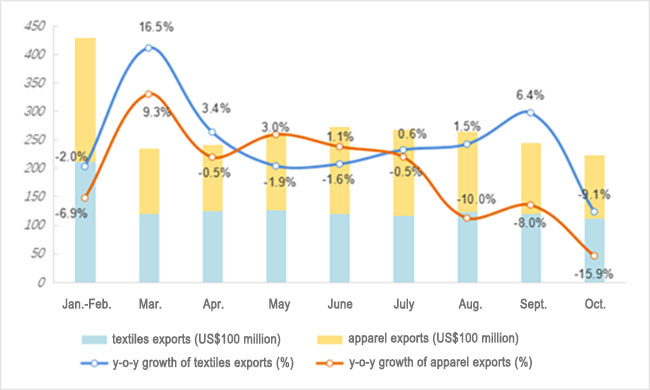2025/11/24
According to the General Administration of Customs, China’s textile and apparel exports in the first ten months amounted to US$243.94 billion, reflecting a slight year-on-year decrease of 1.6%. Among them, textile and apparel exports show divergent performance: textile exports totaled US$117.74 billion, rising by 0.9% year-on-year, while apparel exports reached US$126.2 billion, decreasing by 3.8% year-on-year.
In CNY-denominated terms, textile and garment exports totaled 1.75 trillion yuan, marking a 0.7% year-on-year decrease. Specifically, textile exports were 844.19 billion yuan, up by 1.8% year-on-year; apparel exports amounted to 905 billion yuan, decreasing by 3.0% year-on-year.
Figure: Monthly Statistics of China’s Textiles and Apparel Exports from January to October, 2025

In October alone, China’s textile and apparel exports declined by 9.1% and 15.9% year-on-year, respectively, marking the steepest monthly declines recorded this year. Textile exports experienced a temporary slowdown due to decelerating global inventory replenishment and fluctuating external demand, while apparel exports remained under pressure as consumption recovery in European and American markets lagged and inventory digestion cycles continued to extend. Overall, despite the short-term slowdown in external demand recovery, China’s textile industry maintains solid advantages in its complete industrial chain, strong supporting capabilities, and diversified market layout, providing crucial support for sector operations.
Looking ahead, global consumer markets are expected to continue diverging, with external demand remaining uncertain. It is recommended that Chinese textile enterprises strengthen monitoring and analysis of major export markets, flexibly adjust product portfolios and delivery strategies, and actively expand into potential markets such as ASEAN, the Middle East, and Africa. Concurrently, they should monitor external factors like exchange rates and freight costs, seize opportunities from domestic consumption recovery, enhance competitiveness and resilience through digital and green transformation, and steadily promote coordinated development in both domestic and international markets.
Source: CHINA TEXTILE LEADER Express



Authority in Charge: China National Textile and Apparel Council (CNTAC)
Sponsor: China Textile Information Center (CTIC)
ISSN 1003-3025 CN11-1714/TS
© 2025 China Textile Leader, all rights reserved.
Powered by SeekRay